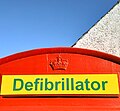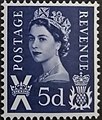Crown of Scotland
| Crown of Scotland | |
|---|---|
 | |
| Heraldic depictions | |
 | |
| Details | |
| Country | Scotland |
| Made | 1540 (remade from previous version) |
| Owner | Charles III in right of the Crown |
| Weight | 1.6 kg (3.5 lb) |
| Arches | 4 |
| Material | Scottish gold and silver[1] |
The Crown of Scotland (
A crown must have been made during the reign of
Made of solid gold and
The Crown of Scotland is kept on public display in the Crown Room at Edinburgh Castle.
Description
The base of the Crown of Scotland is a
The circlet supports the four solid gold arches from the old crown, each of which is decorated with gold and red-enamelled oak leaves. The arches are topped by a gold monde, which is enamelled blue and covered with small gold stars, and topped by a gold cross pattée, set off with black enamel, eight pearls and a large amethyst. James V's royal cypher 'JR5' appears on the lower arm of the cross on top of the crown, enamelled in black.[4] The crown has a red velvet bonnet, with four enamelled gold ornaments adorned with a pearl attached to it between the four arches.[5]
History
Origins
The earliest known depiction of a Scottish monarch wearing a crown is from the reign of Edgar (1097–1107), who was depicted on his Great Seal wearing a crown and holding a sceptre and sword.[6] The first written reference to the Crown of Scotland dates from the abdication of John Balliol in 1296, when the Scottish regalia was described as consisting of a sceptre, sword, crown and ring. The crown and other regalia were seized by the army of Edward I of England in 1296 and taken to England.[7]
Following his seizure of the throne in 1306,
From the reign of Edgar until the reign of James III (1460–1488) the Crown of Scotland was depicted as a circlet or "open" crown surmounted by fleurs de lis around its rim.[13] The first evidence of a change in the form of the crown appears late in the reign of James III, with the king depicted on a silver coin of 1484 wearing an imperial or "closed" crown with four arches surmounted by a monde and cross The earliest illustration of the Crown of Scotland as an imperial crown dates from 1503 when James IV was depicted wearing an imperial crown in the Book of Hours commissioned for his marriage to Margaret Tudor.[14] The accuracy of this depiction of the crown has been questioned, as the artist lived in County of Flanders and would never have seen the crown. The Crown of Scotland most probably assumed the form of an imperial crown when it was remodelled in August 1532.[15] The existing crown was delicate and had been repaired in May 1532, and would be again the following year by Adam Leys.[16]
Remodelled
In January 1540, James V commissioned the royal goldsmith,
16th and 17th centuries
The crown was first worn in the year of its re-modelling by James V to the
18th and 19th centuries
Following the
20th and 21st centuries

On 24 June 1953, following her
The Crown of Scotland has been present at the royal opening ceremonies of the modern Scottish Parliament, including the first in 1999,[20] and the official opening of the new Scottish Parliament Building at Holyrood in 2004.[21] On such occasions the crown, carried by the Duke of Hamilton, the hereditary bearer of the Crown of Scotland, immediately precedes the monarch in the custom of the ancient opening ceremonial procession known as the Riding of Parliament.
The Crown of Scotland was placed upon the coffin of Elizabeth II as she lay-at-rest in St Giles' Cathedral from 12 to 13 September 2022.[22] In July 2023 the Crown was presented to Charles III at a national service of thanksgiving at St Giles' Cathedral.[23]
Appearance in heraldry
As well as appearing in the
Stylised versions of the crown appear upon Scottish version of the
A version of the crown is used upon Royal Mail premises, vehicles and Scottish pillar, lamp and wall boxes, and a metal insert plate showing the Crown of Scotland also appears on model K6 red telephone boxes in Scotland.
From 1927 until its abolition in 1975, the arms of Kincardineshire County Council featured the crown, together with the sword and sceptre, above an artist's rendering of Dunnottar Castle, to mark the county's status as the 17th-century hiding place of the Honours of Scotland during the Wars of the Three Kingdoms.[24]
The Crown of Scotland also appears on maritime flags, including the
From 1968 to 2008, the reverse of the Five pence coin, minted for circulation throughout the United Kingdom, featured the Royal Badge of Scotland – a thistle surmounted by the Crown of Scotland.
The crown, as a component of the Royal Badge of Scotland ('A Thistle Royally Crowned'), appeared on a 'Regional' series of pre-decimal definitive Royal Mail stamps from 1958 to 1970.
In 2003 a new crown was made for the Lord Lyon King of Arms, modelled on the Crown of Scotland.[26] This crown has removable arches (like one of the late Queen Mother's crowns) which will be removed at coronations to avoid any hint of lèse-majesté.[27]
Gallery
-
The ScottishRoyal Cypher of Charles III
-
British Government, (Scotland Office), rendered in full colour. The Crown of Scotland surmounts the escutcheon and both supporters.
-
IN DEFENS
-
blue ensign defacedby an anchor and chain, accompanied by silver letters SF (Scottish Fisheries), within a thistle wreath and surmounted by the Crown of Scotland.
-
Police Scotland vehicle decal showing a stylised version of the Royal Badge of Scotland: A thistle surmounted by the Crown of Scotland
-
The Crown of Scotland is incorporated into the badge of the Scottish Ambulance Service, shown here on the tail of a Eurocopter EC135.
-
Carved version of theKirk of the Canongate, Edinburgh.
-
TheShetland Ponymascot.
-
The badge of the Royal British Legion Scotland showing the Crown of Scotland.
- Royal_Mail
-
A representation of the Crown of Scotland found on cast iron Royal Mail post boxes in Scotland
-
Glass-fibre type PB58 pillar box in Edinburgh, displaying a decal showing a simplified version of the Crown of Scotland
-
Post mounted Royal Mail lamp box inCypher
-
Royal Mail lamp box type LB3426 with the Crown of Scotland on a steel plate. (Prestwick, Scotland)
-
Royal Mail vehicle logo (side door) used in Scotland showing a simplified version of the Crown of Scotland. (A convention adopted after the 1953 Coronation prevents EIIR being used in Scotland)[28]
-
Red telephone box (Model K6), converted to house a defibrillator, showing the Crown of Scotland on an insert plate, (St Edward's Crown insert plates appear on K6 models outwith Scotland).
-
1958-1970 Pre-decimal definitive Royal Mail stamp, featuring the Crown of Scotland in the Royal Badge of Scotland: A Thistle Royally Crowned
See also
References
- ^ The Honours of Scotland, Official website of the British Royal Family.
- ^ Chris Tabraham, The Honours of Scotland: The Story of the Scottish Crown Jewels and the Stone of Destiny (Edinburgh: Historic Environment Scotland, 2019), pp. 50-54.
- ^ Chris Tabraham, The Honours of Scotland (Edinburgh, 2019), pp. 50-54.
- ^ Alexander Brook, 'Technical Description of the Regalia of Scotland', Proceedings of the Society of Antiquaries, 24 (1890), p. 61.
- ^ Chris Tabraham, The Honours of Scotland (Edinburgh, 2019), pp. 50-54.
- ^ Chris Tabraham, The Honours of Scotland (Edinburgh, 2019), p. 17.
- ^ Chris Tabraham, The Honours of Scotland (Edinburgh, 2019), pp. 19-22.
- ^ Chris Tabraham, The Honours of Scotland (Edinburgh, 2019), p. 22.
- ^ Chris Tabraham, The Honours of Scotland: The Story of the Scottish Crown Jewels and the Stone of Destiny (Edinburgh, 2019), p. 25.
- ^ Colm Macnamee, Robert Bruce: Our Most Valiant Prince, King and Lord (Edinburgh, Birlinn, 2018), p. 271.
- ^ Dunbar, Sir Archibald H., Scottish Kings — A Revised Chronology of Scottish History 1005–1625, Edinburgh, 1899, pp. 146–7
- ^ Chris Tabraham, The Honours of Scotland (Edinburgh, 2019), pp. 25-26.
- ^ Chris Tabraham, The Honours of Scotland: The Story of the Scottish Crown Jewels and the Stone of Destiny (2019), p. 44.
- ^ Chris Tabraham, The Honours of Scotland: The Story of the Scottish Crown Jewels and the Stone of Destiny (2019), p. 44.
- ^ Chris Tabraham, 'The Honours of Scotland: The Story of the Scottish Crown Jewels and the Stone of Destiny', (2019), p. 49.
- ^ Chris Tabraham, The Honours of Scotland (Edinburgh, 2019), p. 49: Andrea Thomas, Princelie Majestie, the court of James V (Edinburgh: John Donald, 2005), p. 262.
- ^ Chris Tabraham, The Honours of Scotland (Edinburgh, 2019), p. 50: James Balfour Paul, Accounts of the Treasurer, vol. 7 (Edinburgh, 1907), p. 278.
- ^ James Balfour Paul, Accounts of the Treasurer, vol. 7 (Edinburgh, 1907), p. 285.
- ^ Chris Tabraham, The Honours of Scotland (Edinburgh, 2019), p. 54: Alexander Brook, 'Technical Description of the Regalia of Scotland', Proceedings of the Society of Antiquaries, 24 (1890), p. 63.
- ^ "The Scottish Parliament Parliamentary News Release". Archived from the original on 21 June 2009.
- ^ "The Scottish Parliament Media Briefing Note". Archived from the original on 19 May 2006.
- ^ "Crown of Scotland to be placed on Queen's coffin while it lays-at-rest". The Scotsman. 12 September 2022. Retrieved 12 September 2022.
- ^ "King Charles receives Scottish crown jewels". BBC News. 4 July 2023. Retrieved 5 July 2023.
- ^ "The Coat of Arms of Kincardineshire".
- ^ "The Royal Scottish Motor Yacht Club".
- ^ "Lord Lyon gets his crown back". The Scotsman. 13 July 2003. Retrieved 25 February 2018.
- ^ "Offers of Arms: Kings, Heralds and Pursuivants".
- ^ "Queen Elizabeth II and Scotland". National Records of Scotland. NRS. 31 May 2013. Retrieved 24 July 2019.
External links
- Crown of Scotland – Historic Environment Scotland
- Honours of Scotland – Edinburgh Castle website
- The Honours of Scotland – Royal Household website




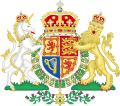







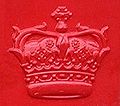
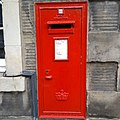




![Royal Mail vehicle logo (side door) used in Scotland showing a simplified version of the Crown of Scotland. (A convention adopted after the 1953 Coronation prevents EIIR being used in Scotland)[28]](http://upload.wikimedia.org/wikipedia/commons/thumb/d/dc/Royal_Mail_vehicle_logo_%28Crown_of_Scotland%29.jpg/120px-Royal_Mail_vehicle_logo_%28Crown_of_Scotland%29.jpg)
